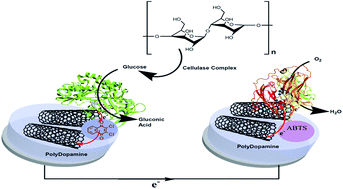Cellulose to electricity conversion by an enzymatic biofuel cell†
Abstract
The conversion of biomass and other cellulose-based materials to clean energy has high promise for a sustainable world. Herein we present a green methodology to convert cellulose directly into electrical power output by utilizing cellulase complex and an enzymatic biofuel cell. An integrated FAD-dependent glucose dehydrogenase (FAD-GDH) based anode and a bilirubin oxidase-based cathode were used for the cell construction. Cellulase complex was utilized for the cellulose to glucose degradation which was then oxidized by the FAD-GDH based anode to generate bioelectrocatalytic currents. The generated electrons were subsequently transferred to a bilirubin oxidase-based cathode for the oxygen reduction reaction. The designed biofuel cell allows direct biomass to electricity conversion, operating under neutral pH and standard conditions. The constructed biofuel cell was optimized under different cell conditions and a maximal operational lifetime of 32 hours was achieved. The optimized cell reached an electrical power of ∼300 μW cm−2 and 600 μW cm−2 under atmospheric and oxygen saturated conditions, respectively. Overall, the introduced one-pot biofuel cell allows the generation of bias-free electrical power while only cellulose and O2 are required for its operation.



 Please wait while we load your content...
Please wait while we load your content...